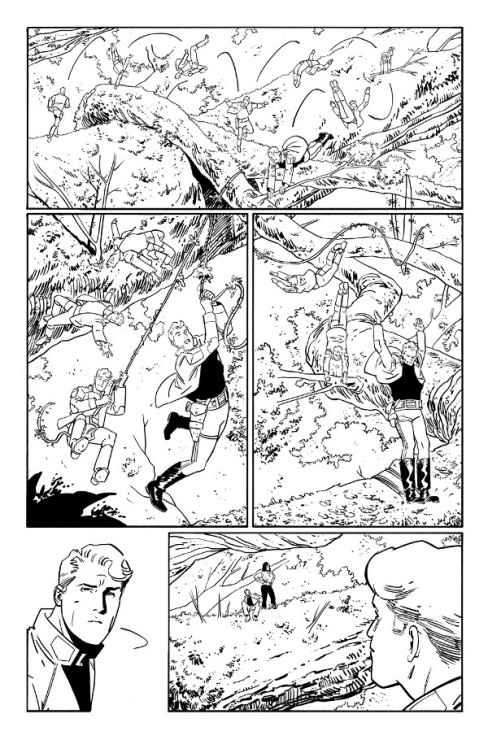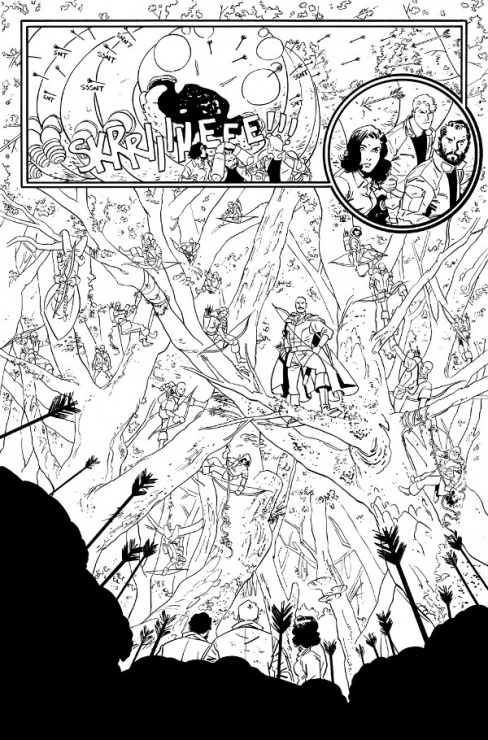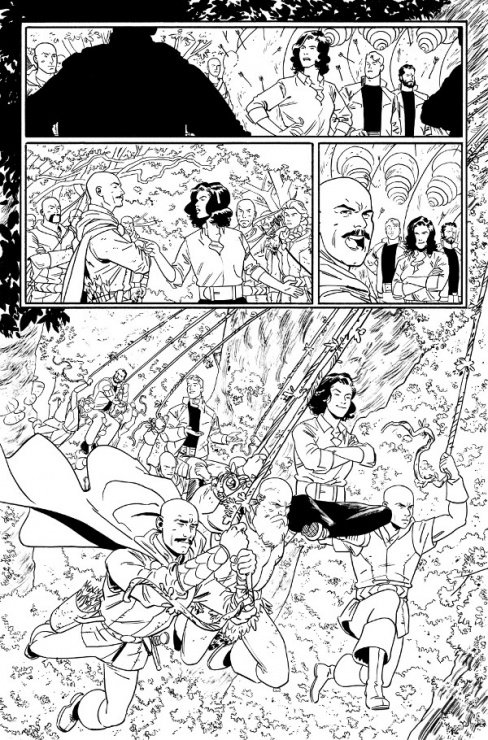Even as comics get better and better from a quality standpoint, one thing that’s strangely missing quite often is any real sense of fun. Comics have moved away from being funny books, and into quite often grim tales about things like “woe” and “darkness”. So when something comes up that is really, truly fun, we can’t help but love it. This week features an amazing example of “FUN” with a capital…well, all of the letters. You saw it. That book is “Flash Gordon” #1 from Jeff Parker, Evan “Doc” Shaner and Jordie Bellaire, and trust me, you’re going to want it.
Four our Artist Alley column, I reached out to Doc to talk about “Flash Gordon”, what his influences are, what makes working with Jeff and Jordie so great, and getting in-depth on some of my favorite pages from the issue with him. All of the pages are unlettered, but beware as these pages come from all over the issue. If you’re worried about spoilers, then I’d recommend avoiding this until after you read the issue.
Also, at the bottom of this interview are inked versions of the pages we looked at. Take a look to see what Doc’s work looks like before Jordie works her magic. It’s pretty damn awesome.
Many people know you for a more classic style that fits well with characters like Captain Marvel and Superman, but was Flash Gordon a character that appealed to you before as an artist? What made this project such an alluring one to you as an artist?
DS: I’m not sure if Flash Gordon specifically was somebody I really wanted to draw, at least at the time. I’ve always liked that type of character, but then Jeff’s take on him really sealed the deal for me. The idea of this smiley positive guy who’s also ready to jump into an adventure at the drop of a hat– that’s definitely something I love drawing. I’m a big fan of Al Williamson so I was already familiar with his work on the character, which I love. That lead me to the original Alex Raymond strips which I really enjoy now. I’m certainly a fan now.
You’re working with two amazing collaborators on this project in Jeff Parker and Jordie Bellaire. How does working with them help you elevate your game, in particular with the way that Jeff scripts the book?
DS: Oh, it’s huge for me. I’ve known Jeff for a while and always wanted to work with him, and I’ve wanted to work with Jordie since I first saw her work. The notion that I’d get to work with both of them on the same book, it’s a dream. And that’s part of it — I’m really getting to work with them. I think we’re all working to each other’s strengths, which can only make the book better. Jeff knows the kinds of things I love to draw, and he’s giving me a chance to do it to the best of my ability. That’s also thanks to Nate Cosby, who somehow tricked Jeff and Jordie into working with me.
Reading this book, it’s clear that your art is very simpatico with the characters and concept, especially the lantern-jawed, almost always smiling lead. You mentioned Al Williamson before, but both inside and outside of comics, who and what would you say are the biggest influences on your work as an artist, particularly for a project like this?
DS: Yeah, Williamson certainly because of the direct link to his Flash Gordon work. Kubert, Wieringo, Toth, and Bernet are the ones who’ve had the biggest influence on me in general, but for this book in particular I’d say probably Kubert and Mark Schultz as well. The second half of the first issue had me poring over Schultz’s work and trying to glean from it. There’s also an artist named Paul Felix who’s worked at Disney for a while now, I’m a huge fan of his development drawings and some of that makes its way into the environments of the book as well.

Can you talk about the way you and Jordie worked on a page like this? The second and fourth panels obviously have very unique and bold coloring, but it’s the type of look that feels to me like you’d have to coordinate closely to achieve it. Was that the case, or is it the type of thing where Jordie is just so damn good she just makes magic wherever she goes?
Continued belowDS: Definitely the latter. I gave Jordie no direction on how to approach the warping in the portals– if anything I was really curious to see what she’d do with it. The sort of rainbow effect is all her and I love it. What’s been nice about this book so far is that I’m almost entirely thinking in black and white and then Jordie comes in and makes it look like I know what I’m doing. She’s fantastic.
The sound effect lettering and how it jumps out of the panels on this page does a lot to add to the fun of the book, and it fits perfectly with your art. Is that something you bring to the table, or does Simon Bowland, the book’s letterer, handle those duties? What do you think those elements add to the page and experience for the reader?
DS: That’s all me. Simon’s great, and it’s not at all that he wouldn’t do a great job of it, it’s more so that I really enjoy doing the sound effects by hand and really making it part of the art. The practical side of it is that’s less that I’m drawing, or less drawing that’s just going to get covered up anyway. I’ve done it for the last few books I’ve worked on and find it makes the process that much more fun for me. I hope the readers like it.
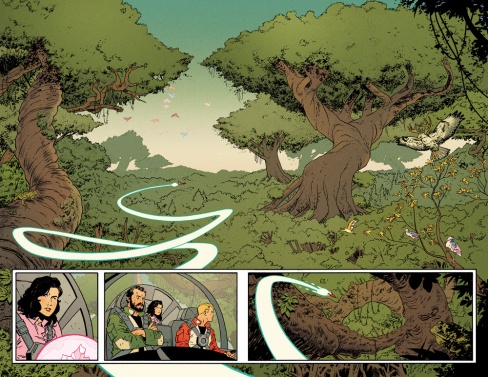
This first issue quickly takes readers through a number of new worlds, including the mega tree land of Arboria. When it comes to building these, how specific was Jeff? Was it more of a case where he said something like, “this planet has huge trees and flora and fauna everywhere!” and unleashed you to do what you do? Or was he very specific?
DS: Somewhere in the middle of those. He’d describe what kind of world we’d see (snow, water, desert, etc.) and then a few specific descriptors for each, but I was given plenty of room to shape the worlds. I threw in all the animals in Arboria but the shape of the trees and the way we never really see the ground was Jeff. It’s been great because then I’m not just starting from nothing but I still have a lot of freedom.

Throughout this issue, you did a phenomenal job of conveying the motion and physicality of Flash as a character, and I love how that motion isn’t just used for action, but as an explanation for him as a character. Beyond that, I just love this type of thing, where an artist conveys every step of the movements. When it comes to a scene like this, how do you put that choreography together? Are you the type who really focuses on something like that to ensure it comes out right, or is it something that you find comes pretty naturally to you in your art?
DS: Thanks! I’m a huge fan of this kind of trick too as it’s something that only comics can pull off that well. Not to mention that if used well it really does a great job of guiding the reader through the page. I wouldn’t say that it comes naturally, I really had to fine tune how exactly he was going to move through it, both in terms of direction and “poses”. Plus it’s a matter of making sure it goes well with the dialogue– his lines during that are attached to specific moves for a reason. It’s a great moment to showcase that Flash has some gymnastics experience in his back pocket, and that it’s relatively effortless for him.
Beyond that, I love how your characters and their body language convey so much of the humor in the story, like the reactions the Doctor and Dale have to Flash’s Cirque du Soleil act. When it comes to character acting, humorous or otherwise, what’s your approach on getting the right feel for a scene or moment? There’s a fine line that could push it to be over the top, but you very much achieve effective and efficient work with your characters that elevates the scene for me as a reader.
Continued belowDS: I started as a humor cartoonist years ago, that had been my plan for a long time. Whether they’re “funny books” or not, books that know how to inject a little humor have always been more appealing to me. So part of it is just being a fan of and being familiar with that kind of timing. Of course, a lot of it comes from the script too. For me personally, I tend to underplay those kind of moments and try to keep it pretty subtle, because the reader doesn’t need us spelling it out to them.
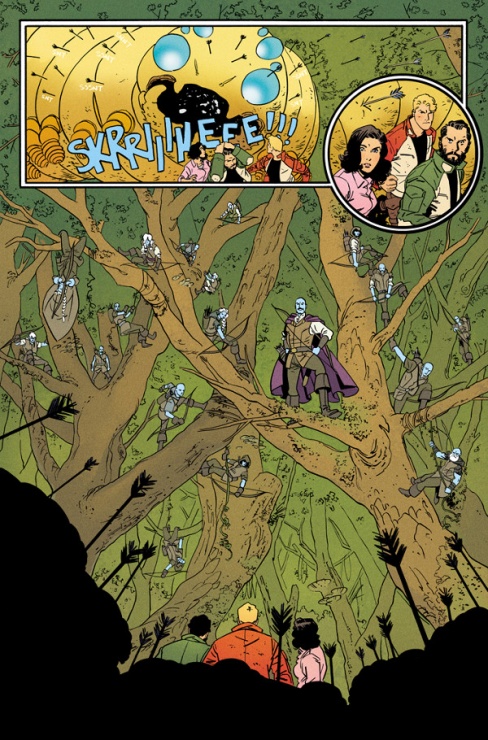
This was something we saw repeated in the issue, but I loved the usage of the circle panels to zoom in on details. When it comes to elements like that, and general layout, how did you and Jeff work? Was an element like that something that you added to better tell the story, or was it something that Jeff had worked into the script? However you did it, it worked tremendously well.
DS: I’m a giant fan of circular panels in comics. Mark Schultz and Dave Stevens are two favorite artists of mine, and they both used circular panels generously and to great effect in Xenozoic Tales and The Rocketeer respectively. I told Jeff and Nate at the beginning that I would be throwing as many of those in there as I could get away with. I don’t remember now how many are in the first issue, but I know Jeff wrote in the one on that page, another was put in by me as a new panel, and the rest are all me turning what would normally be a square panel into a circular one. Again, it’s something that comics in particular can do really well and I love leaning into that kind of thing.
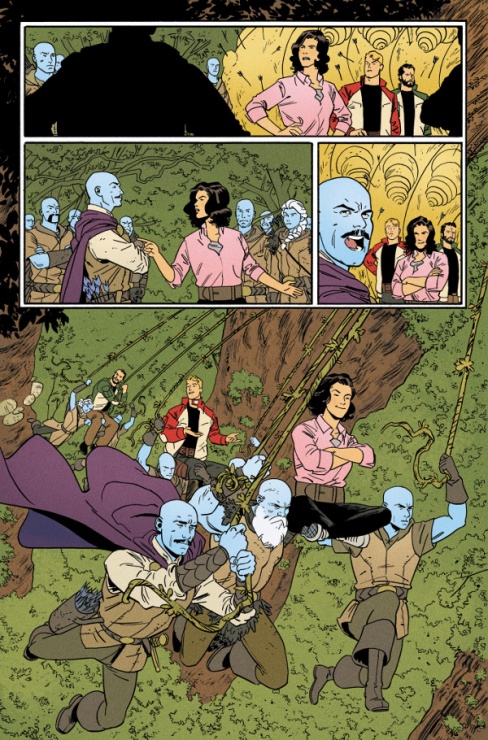
This very last panel on the last page really could be handed out as a teaser for the book, as it conveys the incredible fun the first issue achieves incredibly well. It, and I mean this in the most complimentary of ways, feels like a modernization of the Saturday morning cartoon feel, and this panel achieves that incredibly well. Dale’s pose alone just kills me. This is a really hard question to answer probably, but what do you think they key to the team achieving such a sense of glee and wonder in the storytelling was? Was tone a big point the team talked about going in?
DS: I know that the one word that keeps coming up in the e-mails between us is “FUN”. In all capitals. We’re trying to make this something that we’ll have a good time putting together and that the reader will hopefully get a kick out of. I don’t think we’re consciously going “Well, this thing here is more fun than that” or “Not fun enough! MORE FUN”, we’re not being that technical about it. The tone of the whole book stems from Flash being the kind of guy who faces these worlds, danger and all, with a smile. Everything else just sort of falls into place.


